Do you have a question about the Weil-McLain GOLD CGa and is the answer not in the manual?
Explains the function of the control module in boiler operation.
Describes the transformer's role in reducing line voltage.
Details the draft hood's function in providing minimum draft.
Explains the spill switch's safety function.
Describes the water temperature limit switch function.
Explains the boiler circulator's role and features.
Describes the vent damper's function in reducing heat loss.
Indicates hazards that cause severe personal injury, death, or property damage.
Indicates hazards that can cause severe personal injury, death, or property damage.
Indicates hazards that cause minor personal injury or property damage.
Indicates special instructions important but not related to injury or damage.
Crucial instructions for installers to prevent injury or death.
Directs users to installer/service technician and recommends annual service.
Advises care when handling ceramic fiber and fiberglass materials.
Important safety guidelines for operating the boiler.
Guidelines for boiler water maintenance and preventing damage.
Warnings and precautions regarding glycol use and fire risk.
Lists required codes for boiler installations.
Checklist of items to verify before selecting boiler location.
Warning about keeping the boiler area clear of flammable materials.
Guidance on protecting gas control system from water.
Checks to perform when replacing an old boiler.
Provides recommended clearances for servicing the boiler.
Details requirements for combustion and ventilation air openings.
Specifies minimum clearances from combustible materials.
States that the boiler is approved for combustible flooring but not carpeting.
Outlines requirements for a foundation pad.
Special precautions for installing boilers in residential garages.
Warnings about flue gas spillage and carbon monoxide emissions.
Steps for safely removing a boiler from a common venting system.
Details requirements for chimneys and vents, including height and lining.
Advice on preventing condensation in masonry chimneys.
Guidelines for multiple appliances venting into a common chimney.
Warning about contaminated combustion air and potential injury.
Lists products and areas that can contaminate combustion air.
Explains requirements for combustion air openings based on clearances.
Emphasizes the need for adequate combustion and ventilation air.
Details options for supplying combustion air to the boiler.
Defines free area and provides calculations for louvers.
Describes the requirements for a single combustion air opening.
Defines unusually tight construction and its implications for air openings.
Advises on air openings to handle exhaust fan air movement.
Explains how to interlock motorized air dampers for safety.
Instructions for moving and positioning the boiler.
Guidance on checking manifold orifices and burner seating.
Steps for replacing orifices if necessary.
Instructions for performing a hydrostatic pressure test on the boiler.
Steps to prepare the boiler for the pressure test.
Procedure for filling the boiler and conducting the test.
Steps for draining the boiler and removing fittings after the test.
Instructions for installing the draft hood on the boiler.
Steps for installing and connecting the spill switch.
Procedures for installing the vent damper assembly.
Specific instructions for installing the damper blade based on ignition type.
Specifies minimum clearances for the vent damper.
Identifies different vent damper assemblies.
Covers ASME/Canadian requirements, low water cutoff, and backflow prevention.
Instructions for installing the pressure/temperature gauge.
Details proper installation and safety for the relief valve.
Describes circulator shipping and installation options.
Guidance on system water piping, expansion tanks, and pipe sizing.
Precautions for systems with chillers or air handling units.
Details installation for diaphragm/bladder expansion tanks.
Details installation for closed-type expansion tanks.
Warning about potential damage from low return water temperature.
Refers to previous pages for near-boiler and single-zone piping.
Instructions for zoning using circulators.
Instructions for zoning using zone valves.
Guidance for specific system types.
Warning about potential damage from low return water temperature.
Explains the preferred bypass piping method for low temp systems.
Discusses the use and placement of temperature gauges.
Instructions for adjusting bypass valves.
Warning about potential damage from low return water temperature.
Details the boiler-bypass piping method and its effectiveness.
Discusses temperature gauges for low temperature systems.
Instructions for adjusting bypass valves in low temp systems.
Warning about potential damage from low return water temperature.
Explains the system-bypass piping method and its applications.
Instructions for adjusting bypass valves for system-bypass piping.
Warning about potential damage from low return water temperature.
Guidance on preventing chilled water from entering the boiler.
Steps for connecting the gas supply to the boiler.
Details pipe sizing, inlet pressure, and regulator requirements for natural gas.
Details pipe sizing and regulator requirements for propane gas.
Warnings about checking for gas leaks and using pipe dope.
Instructions for installing and setting the thermostat.
Instructions for connecting power to the junction box.
Guidance on wiring for multiple zone systems.
Procedures for checking for gas leaks before and during operation.
Advises on water treatment based on water hardness and pH.
Recommends consulting water treatment companies for specific conditions.
Guidelines for using antifreeze in hydronic systems.
Detailed steps for filling the boiler system with water and purging air.
Instructions for checking water piping for leaks after filling.
Guidance on checking and securing base insulation.
Instructions for starting the boiler after preparation.
Steps to verify system and boiler status after start-up.
Verifies system piping, vent system, gas odor, and overall operation.
Troubleshooting checklist for when the boiler fails to start.
Describes proper and improper pilot and main burner flames.
How to verify the vent damper opens and closes correctly.
How to check the vent system for proper draft.
Checklist of items to verify before starting the boiler.
Instructions for setting the thermostat.
Section for recording installation and service details.
Overview of operation for standing pilot systems.
Describes the boiler's state when no heat is called for.
Explains how the boiler responds to a call for heat.
Describes operation when a limit control opens.
Guidance on setting the thermostat heat anticipator.
Critical safety warnings before attempting to light the pilot.
Emergency procedures if gas is detected.
Step-by-step guide for lighting the pilot burner.
Procedure for safely turning off gas to the boiler.
Critical safety warnings before attempting to light the pilot.
Emergency procedures if gas is detected.
Step-by-step guide for lighting the pilot burner.
Procedure for safely turning off gas to the boiler.
Overview of operation for spark-ignited pilot systems.
Describes the boiler's state when no heat is called for.
Explains how the boiler responds to a call for heat.
Details the pilot ignition sequence and checks.
Describes main burner operation and sequence.
Explains what happens when the thermostat is satisfied.
Guidance on setting the thermostat heat anticipator.
Illustrates the wiring connections for the spark-ignited pilot system.
Shows the ladder diagram for the spark-ignited pilot system wiring.
Table of gas valve terminals and their corresponding anticipator settings.
General requirements for installing electrical wiring according to codes.
Critical safety warnings before operating the boiler.
Emergency procedures if gas is detected.
Step-by-step guide for operating the boiler.
Procedure for safely turning off gas to the boiler.
Critical safety warnings before operating the boiler.
Emergency procedures if gas is detected.
Step-by-step guide for operating the boiler.
Procedure for safely turning off gas to the boiler.
Critical safety warnings before operating the boiler.
Emergency procedures if gas is detected.
Step-by-step guide for operating the boiler.
Procedure for safely turning off gas to the boiler.
Critical safety warnings before operating the boiler.
Emergency procedures if gas is detected.
Step-by-step guide for operating the boiler.
Procedure for safely turning off gas to the boiler.
A checklist to ensure proper operation after service.
Tasks for the service technician during annual start-up.
Regular maintenance tasks for the owner.
Warning about potential injury or damage from improper service.
Warnings regarding annual inspection and potential hazards.
Verifies combustion and ventilation air openings are clear.
Inspects the flue gas vent system for blockages or leaks.
Addresses any reported issues before proceeding with service.
Checks the boiler area for combustibles and vapors.
Visually inspects pilot and main burner flames for proper operation.
Checks water piping for leaks and signs of damage.
Inspects flue collector and heating surfaces for soot or damage.
Inspects burners, base insulation, and components.
Guidance on checking and oiling system circulators.
Steps for performing the annual start-up procedure.
Checks gas piping for leaks and proper condition.
Verifies system pressure during cold fill and operation.
Inspects automatic air vents and air separators.
Tests boiler limit controls and other safety cutoffs.
Inspects expansion tanks for waterlogging or sizing issues.
Instructions for inspecting and testing the boiler relief valve.
Discusses manual, maintenance schedule, and boiler behavior with owner.
Warnings about wiring errors, bypassing safety devices, and burner access panel.
Lists necessary items and initial checks before troubleshooting.
Verifies wiring connections and gas pressures.
Troubleshooting steps for vent damper malfunctions.
Flowchart for diagnosing why a standing pilot boiler will not fire.
Warnings and notes regarding the control module.
Explains indicator lights that signify a lockout condition.
Explains indicator lights for non-lockout conditions.
Refers to diagrams for control module connections.
Diagram showing connections to the control module.
Diagnosing issues based on the POWER light status.
Diagnosing issues indicated by TSTAT CIRC and POWER lights flashing.
Diagnosing issues indicated by the DAMPER light flashing.
Diagnosing issues indicated by FLAME and POWER lights flashing.
Diagnosing failure to establish the main flame.
Diagnosing insufficient heat or no heat issues.
Overview of replacement parts by section.
Lists replacement parts for the boiler base.
Lists replacement parts for the boiler jacket.
Lists replacement parts for the boiler trim.
Lists replacement parts for boiler controls.
Warning about using genuine parts and handling materials.
Details parts for the boiler's section assembly, including flue collector and draft hood.
Lists parts for the base assembly, insulation, and burner components.
Details replacement jacket panels, junction box, and touch-up paint.
Lists parts for the trim assembly, including relief valves, gauges, circulators, and fittings.
Lists parts for the gas control assembly for standing and spark-ignited pilot systems.
Provides detailed dimensions of the boiler and its connections.
Table listing various dimensions for different boiler models.
Lists boiler input, output, efficiency, and chimney size for different models.
Explains suffixes for pilot ignition systems.
Notes CSA design, ASME rating, and installation for low temperature systems.
Procedures and precautions for removing combustion chamber lining.
Procedures and precautions for handling fiberglass wool and installation.
Explains the function of the control module in boiler operation.
Describes the transformer's role in reducing line voltage.
Details the draft hood's function in providing minimum draft.
Explains the spill switch's safety function.
Describes the water temperature limit switch function.
Explains the boiler circulator's role and features.
Describes the vent damper's function in reducing heat loss.
Indicates hazards that cause severe personal injury, death, or property damage.
Indicates hazards that can cause severe personal injury, death, or property damage.
Indicates hazards that cause minor personal injury or property damage.
Indicates special instructions important but not related to injury or damage.
Crucial instructions for installers to prevent injury or death.
Directs users to installer/service technician and recommends annual service.
Advises care when handling ceramic fiber and fiberglass materials.
Important safety guidelines for operating the boiler.
Guidelines for boiler water maintenance and preventing damage.
Warnings and precautions regarding glycol use and fire risk.
Lists required codes for boiler installations.
Checklist of items to verify before selecting boiler location.
Warning about keeping the boiler area clear of flammable materials.
Guidance on protecting gas control system from water.
Checks to perform when replacing an old boiler.
Provides recommended clearances for servicing the boiler.
Details requirements for combustion and ventilation air openings.
Specifies minimum clearances from combustible materials.
States that the boiler is approved for combustible flooring but not carpeting.
Outlines requirements for a foundation pad.
Special precautions for installing boilers in residential garages.
Warnings about flue gas spillage and carbon monoxide emissions.
Steps for safely removing a boiler from a common venting system.
Details requirements for chimneys and vents, including height and lining.
Advice on preventing condensation in masonry chimneys.
Guidelines for multiple appliances venting into a common chimney.
Warning about contaminated combustion air and potential injury.
Lists products and areas that can contaminate combustion air.
Explains requirements for combustion air openings based on clearances.
Emphasizes the need for adequate combustion and ventilation air.
Details options for supplying combustion air to the boiler.
Defines free area and provides calculations for louvers.
Describes the requirements for a single combustion air opening.
Defines unusually tight construction and its implications for air openings.
Advises on air openings to handle exhaust fan air movement.
Explains how to interlock motorized air dampers for safety.
Instructions for moving and positioning the boiler.
Guidance on checking manifold orifices and burner seating.
Steps for replacing orifices if necessary.
Instructions for performing a hydrostatic pressure test on the boiler.
Steps to prepare the boiler for the pressure test.
Procedure for filling the boiler and conducting the test.
Steps for draining the boiler and removing fittings after the test.
Instructions for installing the draft hood on the boiler.
Steps for installing and connecting the spill switch.
Procedures for installing the vent damper assembly.
Specific instructions for installing the damper blade based on ignition type.
Specifies minimum clearances for the vent damper.
Identifies different vent damper assemblies.
Covers ASME/Canadian requirements, low water cutoff, and backflow prevention.
Instructions for installing the pressure/temperature gauge.
Details proper installation and safety for the relief valve.
Describes circulator shipping and installation options.
Guidance on system water piping, expansion tanks, and pipe sizing.
Precautions for systems with chillers or air handling units.
Details installation for diaphragm/bladder expansion tanks.
Details installation for closed-type expansion tanks.
Warning about potential damage from low return water temperature.
Refers to previous pages for near-boiler and single-zone piping.
Instructions for zoning using circulators.
Instructions for zoning using zone valves.
Guidance for specific system types.
Warning about potential damage from low return water temperature.
Explains the preferred bypass piping method for low temp systems.
Discusses the use and placement of temperature gauges.
Instructions for adjusting bypass valves.
Warning about potential damage from low return water temperature.
Details the boiler-bypass piping method and its effectiveness.
Discusses temperature gauges for low temperature systems.
Instructions for adjusting bypass valves in low temp systems.
Warning about potential damage from low return water temperature.
Explains the system-bypass piping method and its applications.
Instructions for adjusting bypass valves for system-bypass piping.
Warning about potential damage from low return water temperature.
Guidance on preventing chilled water from entering the boiler.
Steps for connecting the gas supply to the boiler.
Details pipe sizing, inlet pressure, and regulator requirements for natural gas.
Details pipe sizing and regulator requirements for propane gas.
Warnings about checking for gas leaks and using pipe dope.
Instructions for installing and setting the thermostat.
Instructions for connecting power to the junction box.
Guidance on wiring for multiple zone systems.
Procedures for checking for gas leaks before and during operation.
Advises on water treatment based on water hardness and pH.
Recommends consulting water treatment companies for specific conditions.
Guidelines for using antifreeze in hydronic systems.
Detailed steps for filling the boiler system with water and purging air.
Instructions for checking water piping for leaks after filling.
Guidance on checking and securing base insulation.
Instructions for starting the boiler after preparation.
Steps to verify system and boiler status after start-up.
Verifies system piping, vent system, gas odor, and overall operation.
Troubleshooting checklist for when the boiler fails to start.
Describes proper and improper pilot and main burner flames.
How to verify the vent damper opens and closes correctly.
How to check the vent system for proper draft.
Checklist of items to verify before starting the boiler.
Instructions for setting the thermostat.
Section for recording installation and service details.
Overview of operation for standing pilot systems.
Describes the boiler's state when no heat is called for.
Explains how the boiler responds to a call for heat.
Describes operation when a limit control opens.
Guidance on setting the thermostat heat anticipator.
Critical safety warnings before attempting to light the pilot.
Emergency procedures if gas is detected.
Step-by-step guide for lighting the pilot burner.
Procedure for safely turning off gas to the boiler.
Critical safety warnings before attempting to light the pilot.
Emergency procedures if gas is detected.
Step-by-step guide for lighting the pilot burner.
Procedure for safely turning off gas to the boiler.
Overview of operation for spark-ignited pilot systems.
Describes the boiler's state when no heat is called for.
Explains how the boiler responds to a call for heat.
Details the pilot ignition sequence and checks.
Describes main burner operation and sequence.
Explains what happens when the thermostat is satisfied.
Guidance on setting the thermostat heat anticipator.
Illustrates the wiring connections for the spark-ignited pilot system.
Shows the ladder diagram for the spark-ignited pilot system wiring.
Table of gas valve terminals and their corresponding anticipator settings.
General requirements for installing electrical wiring according to codes.
Critical safety warnings before operating the boiler.
Emergency procedures if gas is detected.
Step-by-step guide for operating the boiler.
Procedure for safely turning off gas to the boiler.
Critical safety warnings before operating the boiler.
Emergency procedures if gas is detected.
Step-by-step guide for operating the boiler.
Procedure for safely turning off gas to the boiler.
Critical safety warnings before operating the boiler.
Emergency procedures if gas is detected.
Step-by-step guide for operating the boiler.
Procedure for safely turning off gas to the boiler.
Critical safety warnings before operating the boiler.
Emergency procedures if gas is detected.
Step-by-step guide for operating the boiler.
Procedure for safely turning off gas to the boiler.
A checklist to ensure proper operation after service.
Tasks for the service technician during annual start-up.
Regular maintenance tasks for the owner.
Warning about potential injury or damage from improper service.
Warnings regarding annual inspection and potential hazards.
Verifies combustion and ventilation air openings are clear.
Inspects the flue gas vent system for blockages or leaks.
Addresses any reported issues before proceeding with service.
Checks the boiler area for combustibles and vapors.
Visually inspects pilot and main burner flames for proper operation.
Checks water piping for leaks and signs of damage.
Inspects flue collector and heating surfaces for soot or damage.
Inspects burners, base insulation, and components.
Guidance on checking and oiling system circulators.
Steps for performing the annual start-up procedure.
Checks gas piping for leaks and proper condition.
Verifies system pressure during cold fill and operation.
Inspects automatic air vents and air separators.
Tests boiler limit controls and other safety cutoffs.
Inspects expansion tanks for waterlogging or sizing issues.
Instructions for inspecting and testing the boiler relief valve.
Discusses manual, maintenance schedule, and boiler behavior with owner.
Warnings about wiring errors, bypassing safety devices, and burner access panel.
Lists necessary items and initial checks before troubleshooting.
Verifies wiring connections and gas pressures.
Troubleshooting steps for vent damper malfunctions.
Flowchart for diagnosing why a standing pilot boiler will not fire.
Warnings and notes regarding the control module.
Explains indicator lights that signify a lockout condition.
Explains indicator lights for non-lockout conditions.
Refers to diagrams for control module connections.
Diagram showing connections to the control module.
Diagnosing issues based on the POWER light status.
Diagnosing issues indicated by TSTAT CIRC and POWER lights flashing.
Diagnosing issues indicated by the DAMPER light flashing.
Diagnosing issues indicated by FLAME and POWER lights flashing.
Diagnosing failure to establish the main flame.
Diagnosing insufficient heat or no heat issues.
Overview of replacement parts by section.
Lists replacement parts for the boiler base.
Lists replacement parts for the boiler jacket.
Lists replacement parts for the boiler trim.
Lists replacement parts for boiler controls.
Warning about using genuine parts and handling materials.
Details parts for the boiler's section assembly, including flue collector and draft hood.
Lists parts for the base assembly, insulation, and burner components.
Details replacement jacket panels, junction box, and touch-up paint.
Lists parts for the trim assembly, including relief valves, gauges, circulators, and fittings.
Lists parts for the gas control assembly for standing and spark-ignited pilot systems.
Provides detailed dimensions of the boiler and its connections.
Table listing various dimensions for different boiler models.
Lists boiler input, output, efficiency, and chimney size for different models.
Explains suffixes for pilot ignition systems.
Notes CSA design, ASME rating, and installation for low temperature systems.
Procedures and precautions for removing combustion chamber lining.
Procedures and precautions for handling fiberglass wool and installation.
| Model | GOLD CGa |
|---|---|
| Fuel Type | Natural Gas or Propane |
| Dimensions | Varies by model |
| Heat Exchanger Material | Cast Iron |
| AFUE | 80% |
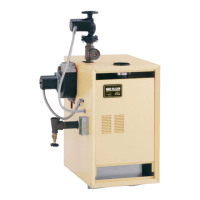
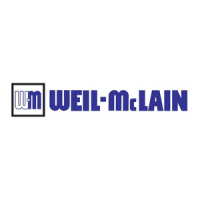




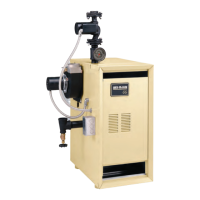

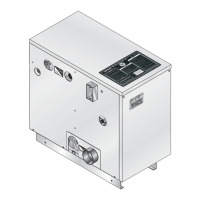
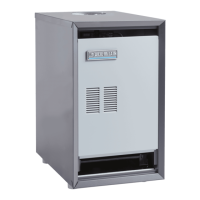
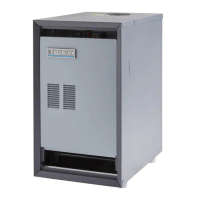

